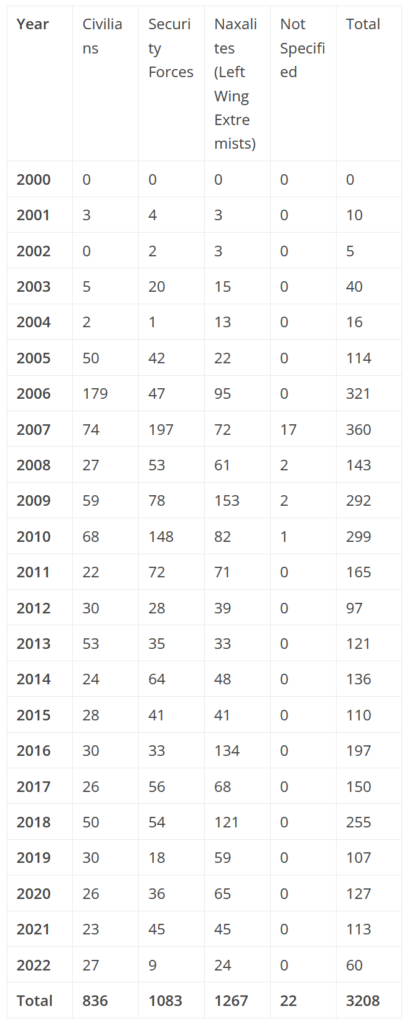India: Perilous Division In Bastar, Chhattisgarh – Analysis
On November 15, 2022, a 34-year-old man, identified as Manker Hurra, was killed by suspected Communist Party of India-Maoist (CPI-Maoist) cadres in Hurrapinjodi village in the Antagarh Tehsil (revenue unit) of Kanker District in the Bastar Division. A group of Maoists abducted Hurra from the village in the night of November 15, and his body was found in the nearby forest in the morning with wound from a sharp-edged weapon on the neck. The reason behind the murder is yet to be ascertained. Manker was the brother of a former Sarpanch (head of the Panchayat, village level local self-Government institution) of Hurrapinjodi village.
On October 24, 2022, CPI-Maoist cadres abducted and killed, Basant Jhadi, the brother of a journalist, on suspicion of being a ‘police informer’, in the Bijapur District of Bastar Division. Jhadi was abducted by Maoists on October 21 and killed on October 24 after a jan adalat (a Maoist ‘people’s court’ or kangaroo court) in Kotapalli village on the Chhattisgarh-Telangana border.
On October 17, 2022, CPI-Maoist cadres killed two persons in a forested area under Gangaloor Police Station limits in Bijapur District. Inspector General of Police (IGP), Bastar Range, Sundarraj P., disclosed, “We have initial information that Maoists have allegedly killed two persons in Pedakorma and Pusnar villages under Gangaloor police station limits” and added that one of the deceased was believed to be Raju Podiyami, the brother of ‘Gangaloor area committee secretary’ of the CPI-Maoist, Dinesh Modiyam. The other victim was identified as a villager, Dula Kodme.
According to partial data collated by the South Asia Terrorism Portal (SATP), the Bastar Division has accounted for at least 27 civilian killings in Left Wing Extremism (LWE)-linked violence in the current year, with over a month yet to go (data till November 20, 2022).
During the corresponding period in 2021, the Division had recorded 20 such fatalities. Through 2021, the Division accounted for 23 civilian fatalities.
The Bastar Division comprises seven Districts – Bastar, Bijapur, Dantewada, Kanker, Kondagaon, Narayanpur, and Sukma. Fatalities in the Bastar Division: 2000* – 2022**

Of some concern is the fact that fatalities in civilian category, which had declined year-on-year between 2019 and 2021, have again risen in 2022.
The fatalities alone do not give an adequate assessment of the Maoist threat to the civilian population. In one such recent case, on October 7, 2022, the Maoists threatened to kill a former Sarpanch, Lakhmu Ram Sarfe of Bade Tevada village under Ambeda Police Station limits in Kanker District, accusing him of being a ‘police informer’. Banners, posters and pamphlets in the village, warned of ‘punishment’ in a ‘jan adalat’ and made many serious allegations against Lakhmu, including embezzling money and extortion from laborers, on the promise of getting the jobs. Such threats and warnings are common, even if the Maoist capacities for their execution has substantially diminished.
Nevertheless, a critical reason for the rise in insecurity among the civilians, as data suggests, is the increasing success of the Maoists on the ground in 2022. For the first time after 2015, the SF:Maoist kill ratio had risen to equality, at 1:1, in 2021. In all the years between 2016 and 2020, SFs had maintained a positive kill ratio: 1:4.06 (2016), 1:1.21 (2017), 1:2.24 (2018), 1:3.2 (2019) and 1:1.8 (2020).
Moreover, the number of Maoists killed in 2021, at 45, was the lowest since 2015, when it was 41. On the other hand, the number of SFs killed in 2021 was highest since 2018, when there were 54 fatalities in this category.
Interestingly, however, Brigadier (Retd.) B. K. Ponwar, Director of the Kanker-based Counter Terrorism and Jungle Warfare College, argued that the Maoists targeting civilians was indicative of the fact that the rebels were upset with the local population, who were turning towards the SFs as the latter increased their dominance across the Division. Ponwar noted, “The soft targets cannot retaliate. Maoist cadres surrendering, getting caught or killed frustrates them, so they look for soft options.”
Meanwhile, according to a July 15, 2022, report, the Chhattisgarh Government claimed that nearly 600,000 people of 589 villages of the Bastar Division had been completely freed from the influence of the Naxalites. A total of 118 villages in Dantewada District, 115 villages in Bijapur District, 121 villages in Sukma District, 92 villages in Kanker District, 63 villages in Bastar District, 48 villages in Narayanpur District and 32 villages in Kondagaon District, had been freed from Maoist influence.
On the other hand, IGP, Sundarraj P., asserting that the SFs were committed to wipe out the Maoist activities, but conceded, “In Bastar Range, though civilian killings have reduced to a great extent, from 279 in the year 2006, to 29 in 2022, it is still an area of major concern in left-wing extremist affected areas.”
Indeed, looking at the LWE situation in the Bastar Division, on June 19, 2021, the Union Ministry of Home Affairs (UMHA), classified six of the seven districts in the Division – Bastar, Bijapur, Dantewada, Kanker, Narayanpur, and Sukma – among the 25 ‘Most Affected LWE Districts’ in eight States. Further, Kondagaon is classified as a ‘District of Concern’. Meanwhile, UMHA included all the seven districts of the Division, among the 70 LWE-affected Districts in 10 States across India, to be covered under the Centre’s ‘Security Related Expenditure (SRE)’ scheme, which funds focused operations against the ultras.
LWE violence has seen a dramatic waning in Chhattisgarh, particularly in the ‘heartland’ areas of the Bastar Division, even as the rebels have lost influence in their areas of activity across India. Nevertheless, the Maoists retain significant operational capacities, and the Bastar Division is the location of some of their last bastions that remain to be freed from their depredations.
